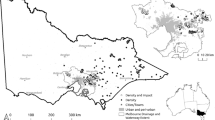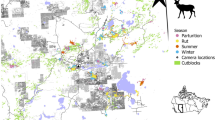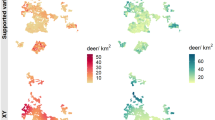Abstract
Axis deer (Axis axis), an introduced invasive species of growing concern around the globe, have rapidly expanded through the southern cone countries in South America. Despite increasing culling efforts over 14 years, axis deer remained abundant at El Palmar National Park in north-eastern Argentina. We tested whether this continued abundance possibly reflected control failures as a result of adjacent plantation forests providing a safe-haven refuge for deer. We carried out a cross-sectional survey of deer faecal pellet groups and tracks in 77 matched pairs of 25 m2 plots deployed at random over the park–plantation interface and assessed the presence of deer trails along the 14.2-km wire fence between both land-use types. The relative odds of having at least one pellet group (occupancy) were 4.5 (95% CI 1.5 to 18.3) times higher among park plots than plantation plots. Using generalized linear mixed models, the relative odds of occupancy decreased significantly with increasing distance to the main permanent water course, but it was 83% lower in plantation plots than in the park plots. Principal component analysis of shrub cover, plant structure and plant height revealed greater shelter within the park. Deer trails were spatially aggregated up to 2300 m and were directly associated with deer occupancy. These results indicate that, in El Palmar National Park interface, plantation forests do not provide a refuge or selected habitat, and suggest instead that the environmental characteristics and diversity of habitats within the protected area are relevant for the effectiveness of the exotic ungulate management program.







Similar content being viewed by others
Availability of data and material
The datasets generated and analysed during the current study are available from the corresponding author on reasonable request.
References
Ahrestani FS, Heitkönig IMA, Matsubayashi H, Prins HHT (2016) Grazing and browsing by large herbivores in South and Southeast Asia. In: Ahrestani FS, Sankaran M (eds) The ecology of large herbivores in south and southeast Asia. Series: ecological studies. Springer, Dordrecht 225:99–120
Ali R (2004) The effect of introduced herbivores on vegetation in the Andaman Islands. Curr Sci 86:1103–1112
Ali R, Pelkey N (2013) Satellite images indicate vegetation degradation due to invasive herbivores in the Andaman Islands. Curr Sci 105:209–214
Alves J, da Silva AA, Soares AM, Fonseca C (2014) Spatial and temporal habitat use and selection by red deer: the use of direct and indirect methods. Mammal Biol 79:338–348. https://doi.org/10.1016/j.mambio.2014.05.007
Baddeley A, Turner R (2005) spatstat: an R package for analyzing spatial point patterns. J Stat Softw 12:1–42. http://www.jstatsoft.org/v12/i06/.
Ballari SA, Cuevas MF, Ojeda RA, Navarro JL (2015) Diet of wild boar (Sus scrofa) in a protected area of Argentina: the importance of baiting. Mammal Res 60:81–87. https://doi.org/10.1007/s13364-014-0202-0
Bates D, Maechler M, Bolker B, Walker S (2015) Fitting linear mixed-effects models using lme4. J Stat Softw 67:1–48. https://doi.org/10.18637/jss.v067.i01
Batista WB, Rolhauser AG, Biganzoli F, Burkart, SE, Goveto L, Maranta A, Pignataro AG, Morandeira NS, Rabadán M (2014) Savanna plant community types at El Palmar National Park (Argentina). Darwiniana, nueva serie 2:5–38. https://doi.org/10.14522/darwiniana.2014.21.569
Bennett A, Haydon S, Stevens M, Coulson G (2015) Culling reduces fecal pellet deposition by introduced sambar (Rusa unicolor) in a protected water catchment. Wildl Soc Bull 39:268–275. https://doi.org/10.1002/wsb.522
Bhattarai BP, Kindlmann P (2012) Habitat heterogeneity as the key determinant of the abundance and habitat preference of prey species of tiger in the Chitwan National Park. Nepal Acta Theriol 57:89–97. https://doi.org/10.1007/s13364-011-0047-8
Bivand R, Keitt T, Rowlingson B (2018) rgdal: bindings for the geospatial data abstraction library. R package version 1.3–3. https://CRAN.R-project.org/package=rgdal
Bivand R, Lewin-Koh N (2019) maptools: tools for handling spatial objects. R package version 0.9–9. https://CRAN.R-project.org/package=maptools
Borkowski J, Pudełko M (2007) Forest habitat use and home-range size in radio-collared fallow deer. Ann Zool Fenn 44:107–114
Brook BW, Sodhi NS, Bradshaw CJ (2008) Synergies among extinction drivers under global change. Trends Ecol Evol 23:453–460. https://doi.org/10.1016/j.tree.2008.03.011
Catt DC, Staines BW (1987) Home range use and habitat selection by red deer (Cerrus elaphus) in a Sitka spruce plantation as determined by radio-tracking. J Zool 211:681–693. https://doi.org/10.1111/j.1469-7998.1987.tb04479.x
Caughley G (1977) Analysis of vertebrate populations. Wiley, Oxford
Challies CN (1977) Effects of commercial hunting on red deer densities in the Arawata Valley, South Westland, 1972–76. N Z J for Sci 7:263–273
Chebez JC, Rodríguez GO (2014) La fauna gringa: especies introducidas en la Argentina. Fundación de Historia Natural Félix de Azara, Buenos Aires
Clevenger AP, Chruszcz B, Gunson KE (2001) Highway mitigation fencing reduces wildlife-vehicle collisions. Wildl Soc Bull (1976–2006) 29:646–653. http://www.jstor.org/stable/3784191
Clout MN, Russell JC (2008) The invasion ecology of mammals: a global perspective. Wildl Res 35:180–184. https://doi.org/10.1071/WR07091
Coelho M, Juen L, Mendes-Oliveira AC (2014) The role of remnants of Amazon savanna for the conservation of Neotropical mammal communities in eucalyptus plantations. Biodivers Conserv 23:3171–3184. https://doi.org/10.1007/s10531-014-0772-9
Cravino A, Brazeiro A (2021) Grassland afforestation in South America: local scale impacts of eucalyptus plantations on Uruguayan mammals. For Ecol Manag 484:118937. https://doi.org/10.1016/j.foreco.2021.118937
D’Amico M, Périquet S, Román J, Revilla E (2016) Road avoidance responses determine the impact of heterogeneous road networks at a regional scale. J Appl Ecol 53:181–190. https://doi.org/10.1111/1365-2664.12572
da Rosa CA, de Almeida Curi NH, Puertas F, Passamani M (2017) Alien terrestrial mammals in Brazil: current status and management. Biol Invasions 19:2101–2123. https://doi.org/10.1007/s10530-017-1423-3
da Rosa CA, Ribeiro BR, Bejarano V, Puertas FH, Bocchiglieri A, dos Santos Barbosa AL et al (2020) NEOTROPICAL ALIEN MAMMALS: a data set of occurrence and abundance of alien mammals in the Neotropics. Ecology. Accepted Author Manuscript. https://doi.org/10.1002/ecy.3115
Davis NE, Coulson G (2016) Habitat-specific and season-specific faecal pellet decay rates for five mammalian herbivores in south-eastern Australia. Aust Mammal 38:105–116. https://doi.org/10.1071/AM15007
Dinerstein E (1980) An ecological survey of the Royal Karnali-Bardia Wildlife Reserve, Nepal: part III: ungulate populations. Biol Conserv 18:5–37. https://doi.org/10.1016/0006-3207(80)90063-4
Enoki T, Yabe T, Koizumi T (2016) Changes in spatial patterns of sika deer distribution and herbivory of planted seedlings: a comparison before and after deer population control by culling. J For Res 21:84–91. https://doi.org/10.1007/s10310-015-0515-0
FAO (2020) Global forest resources assessment 2020: main report. Food and Agriculture Organization, Rome. https://doi.org/10.4060/ca9825en
Forsyth DM, Pople A, Woodford L, Brennan M, Amos M, Moloney PD, Fanson B, Story G (2019) Landscape-scale effects of homesteads, water, and dingoes on invading chital deer in Australia’s dry tropics. J Mammal 100:1954–1965. https://doi.org/10.1093/jmammal/gyz139
Graf W, Nichols L (1966) The axis deer in Hawaii. J Bombay Nat Hist Soc 63:629–734
Gürtler RE, Izquierdo VM, Gil G, Cavicchia M, Maranta A (2017) Coping with wild boar in a conservation area: impacts of a 10-year management control program in north-eastern Argentina. Biol Invasions 19:11–24. https://doi.org/10.1007/s10530-016-1256-5
Gürtler RE, Rodríguez-Planes LI, Gil G, Izquierdo VM, Cavicchia M, Maranta A (2018) Differential long-term impacts of a management control program of axis deer and wild boar in a protected area of north-eastern Argentina. Biol Invasions 20:1431–1447. https://doi.org/10.1007/s10530-017-1635-6
Hanley TA (1983) Black-tailed deer, elk, and forest edge in a western cascades watershed. J Wildl Manag 47:237–242. https://doi.org/10.2307/3808076
Hothorn T, Bretz F, Westfall P (2008) Simultaneous inference in general parametric models. Biom J 50:346–363. https://doi.org/10.1002/bimj.200810425
Iezzi ME, Cruz P, Varela D, De Angelo C, Di Bitetti MS (2018) Tree monocultures in a biodiversity hotspot: impact of pine plantations on mammal and bird assemblages in the Atlantic Forest. For Ecol Manag 424:216–227. https://doi.org/10.1016/j.foreco.2018.04.049
Iezzi ME, De Angelo C, Di Bitetti MS (2020) Tree plantations replacing natural grasslands in high biodiversity areas: how do they affect the mammal assemblage?. For Ecol Manag 473:118303. https://doi.org/10.1016/j.foreco.2020.118303
Kiffner C, Lee DE (2019) Population dynamics of browsing and grazing ungulates in the Anthropocene. In: Gordon IJ, Prins HHT (eds) The ecology of browsing and grazing II. Series: ecological studies. Springer, Cham 239:155–180
Kröger M (2012) The expansion of industrial tree plantations and dispossession in Brazil. Dev Change 43:947–973. https://doi.org/10.1111/j.1467-7660.2012.01787.x
Lantschner MV, Rusch V, Hayes JP (2013) Do exotic pine plantations favour the spread of invasive herbivorous mammals in Patagonia?. Austral Ecol 38:338–345. https://doi.org/10.1111/j.1442-9993.2012.02411.x
Latham J, Staines BW, Gorman ML (1996) The relative densities of red (Cervus elaphus) and roe (Capreolus capreolus) deer and their relationship in Scottish plantation forests. J Zool 240:285–299. https://doi.org/10.1111/j.1469-7998.1996.tb05285.x
Latham J, Staines BW, Gorman ML (1997) Correlations of environmental variables with red (Cervus elaphus) and roe (Capreolus capreolus) deer in Scottish plantation forests. J Zool 242:681–704. https://doi.org/10.1111/j.1469-7998.1997.tb05820.x
Lele SR, Keim, JL, Solymo P (2019) ResourceSelection: resource selection (probability) functions for use-availability data. R package version 0.3–4. https://CRAN.R-project.org/package=ResourceSelection
Lele SR, Merrill EH, Keim J, Boyce MS (2013) Selection, use, choice and occupancy: clarifying concepts in resource selection studies. J Anim Ecol 82:1183–1191. https://doi.org/10.1111/1365-2656.12141
Lindenmayer D, Messier C, Paquette A, Hobbs RJ (2015) Managing tree plantations as novel socioecological systems: Australian and North American perspectives. Can J for Res 45:1427–1433. https://doi.org/10.1139/cjfr-2015-0072
Long JL (2003) Introduced mammals of the world: their history, distribution and influence. CABI Publishing, Wallingford
Lüdecke D (2018a) ggeffects: tidy data frames of marginal effects from regression models. J Open Source Softw 3:772. https://doi.org/10.21105/joss.00772
Lüdecke D (2018b) sjPlot: data visualization for statistics in social science. R Package Version 2.5.0. https://doi.org/10.5281/zenodo.1308157
Mateucci SD, Colma A (1982) Metodología para el estudio de la vegetación. Series: Biologia Monografia, vol. 22. Secretaría General de la Organización de los Estados Americanos
Mathur PK, Kumar H, Lehmkuhl JF, Tripathi A, Sawarkar VB, De R (2011) Mammal indicator species for protected areas and managed forests in a landscape conservation area of northern India. Biodivers Conserv 20:1–7
Miñarro F, Bilenca D (2008) The conservation status of temperate grasslands in central Argentina. Special report. Fundación Vida Silvestre Argentina. http://awsassets.wwfar.panda.org/downloads/conservation_status_temperate_grasslands.pdf. Accessed 27 Oct 2020
Mishra HR (1982) Ecology and behaviour of Chital (Axis axis) in the Royal Chitwan National Park, Nepal (with comparative studies of hog deer (Axis porcinus), sambar (Cervus unicolor) and barking deer (Muntiacus muntjak)). PhD dissertation, University of Edinburgh
Morrison ML, Block WM, Strickland MD, Collier BA, Peterson MJ (2008) Wildlife study design. Springer Science and Business Media, New York
Moe SR, Wegge P (1994) Spacing behaviour and habitat use of axis deer (Axis axis) in lowland Nepal. Canadian J Zool 72:1735–1744. https://doi.org/10.1139/z94-234
Moe SR, Wegge P (1997) The effects of cutting and burning on grass quality and axis deer (Axis axis) use of grassland in lowland Nepal. J Trop Ecol 13:279–292. https://www.jstor.org/stable/2560129
Mooney HA (2005) Invasive alien species: a new synthesis (Vol. 63). Island press, Washington
Neff DJ (1968) The pellet-group count technique for big game trend, census, and distribution: a review. J Wildl Manag 32:597–614. https://doi.org/10.2307/3798941
Nentwig W, Bacher S, Kumschick S, Pyšek P, Vilà M (2017) More than 100 worst alien species in Europe. Biol Invasions 20:1611–1621. https://doi.org/10.1007/s10530-017-1651-6
Neumann W, Ericsson G, Dettki H, Bunnefeld N, Keuler NS, Helmers DP, Radeloff VC (2012) Difference in spatiotemporal patterns of wildlife road-crossings and wildlife-vehicle collisions. Biol Conserv 145:70–78. https://doi.org/10.1016/j.biocon.2011.10.011
Nicosia G, Rodríguez-Planes LI, Maranta AA, Morel A, Gürtler RE (2021) Combining citizen science and recreational hunters to monitor exotic ungulates and native wildlife in a protected area of northeastern Argentina. Biol Invasions, in press. https://doi.org/10.1007/s10530-021-02606-4
Nudds TD (1977) Quantifying the vegetative structure of wildlife cover. Wildl Soc Bull 5:113–117. https://www.jstor.org/stable/3781453
Oksanen JF, Blanchet G, Friendly M, Kindt R, Legendre P, McGlinn D, Minchin PR, O’Hara RB, Simpson G L, Solymo P, Stevens MHH, Szoecs E, Wagner H (2019) vegan: community ecology package. R package version 2.5–4. https://CRAN.R-project.org/package=vegan
Page A, Kirkpatrick W, Massam M (2008) Axis deer (Axis axis) risk assessment for Australia. http://issg.org/database/species/reference_files/ausriskassessments/axiaxi.pdf. Accessed 23 Apr 2021
Peel MC, Finlayson BL, McMahon TA (2007) Updated world map of the Köppen-Geiger climate classification. Hydrology and Earth System Sciences Discussions, European Geosciences Union 4:439–473. https://hal.archives-ouvertes.fr/hal-00298818. Accessed 27 Oct 2020
Pereira-Garbero R, Barreneche JM, Laufer G, Achaval F, Arim M (2013) Mamíferos invasores en Uruguay, historia, perspectivas y consecuencias. Rev Chil Hist Nat 86:403–421. https://doi.org/10.4067/S0716-078X2013000400003
Putman RJ (1984) Facts from faeces. Mammal Rev 14:79–97. https://doi.org/10.1111/j.1365-2907.1984.tb00341.x
QGIS Development Team (2018) QGIS Geographic Information System. Open Source Geospatial Foundation Project. http://qgis.osgeo.org
R Core Team (2020) R: a language and environment for statistical computing. R Foundation for Statistical Computing, Vienna, Austria. https://www.R-project.org/.
Ramesh T, Kalle R, Rosenlund H, Downs CT (2016) Native habitat and protected area size matters: preserving mammalian assemblages in the Maputaland Conservation Unit of South Africa. For Ecol Manag 360:20–29. https://doi.org/10.1016/j.foreco.2015.10.005
Ramírez-Mejía AF, Sánchez F (2016) Activity patterns and habitat use of mammals in an Andean forest and a Eucalyptus reforestation in Colombia. Hystrix It J Mammal 27:1–7
Rolhauser AG, Chaneton EJ, Batista WB (2011) Influence of conspecific and heterospecific adults on riparian tree species establishment during encroachment of a humid palm savanna. Oecologia 167:141–148
Ruiz M (2017) Ecología de mamíferos exóticos en predios forestales de los Departamentos de Río Negro y Flores, Uruguay. MSc dissertation, Universidad de la República
Scalera R, Rabitsch W, Genovesi P, Bacher S, Adriaens T, Verzelen Y et al (2020) Risk assessment & annex on measures for Axis deer Axis axis (Erxleben, 1777): risk assessment developed under the Study on invasive alien species – development of risk assessments to tackle priority species and enhance prevention Contract No 07.0202/2018/788519/ETU/ENV.D.2. In Roy HE, Rabitsch W, Scalera R (eds) Development of risk assessments to tackle priority species and enhance prevention: final report, executive summary and annexes: Contract No 07.0202/2018/788519/ETU/ENV.D.2. Publication Office of the European Union, Luxembourg, pp 1–96. https://doi.org/10.2779/56374
Staines BW, Welch D (1984) Habitat selection and impact of red (Cervus elaphus L.) and roe (Capreolus capreolus L.) deer in a Sitka spruce plantation. P Roy Soc Edinb B 82:303–319. https://doi.org/10.1017/S026972700000381X
Tak PC, Lamba BS (1984) Ecology and ethology of the spotted deer Axis axis (Erxleben) (Artiodactyla: Cervidae). Rec Zool Surv India Occ Paper 43
Tejeda-Cruz C, Naranjo EJ, Cuarón AD, Perales H, Cruz-Burguete JL (2009) Habitat use of wild ungulates in fragmented landscapes of the Lacandon Forest, Southern Mexico. Mammalia 73:211–219. https://doi.org/10.1515/MAMM.2009.044
Tellarini JF, Cirignoli S, Aprile G, Sobral Zotta N, Varela D, Maranta A, Fracassi N, Lartigau B, Gómez Villafañe I (2019) Axis axis. In: SAyDS–SAREM (eds) Categorización 2019 de los mamíferos de Argentina según su riesgo de extinción. Lista Roja de los mamíferos de Argentina. https://cma.sarem.org.ar/es/especie-exotica/axis-axis. Accessed 27 Oct 2020.
Tyers M (2017) Riverdist: river network distance computation and applications. R package version 0.15.0. https://CRAN.R-project.org/package=riverdist
Venables WN, Ripley BD (2002) Modern applied statistics with S, 4th edn. Springer, New York
VerCauteren KC, Lavelle MJ, Hygnstrom S (2006) From the field: fences and deer-damage management: a review of designs and efficacy. Wildl Soc Bull 34:191–200. https://doi.org/10.2193/0091-7648(2006)34[191:FADMAR]2.0.CO;2
Volery L, Jatavallabhula D, Scillitani L, Bertolino S, Bacher S (2021) Ranking alien species based on their risks of causing environmental impacts: a global assessment of alien ungulates. Glob Change Biol 27:1003–1016. https://doi.org/10.1111/gcb.15467
Wickham H (2016) Ggplot2: elegant graphics for data analysis. Springer Verlag, New York
With KA (2002) The landscape ecology of invasive spread. Conserv Biol 16:1192–1203. https://doi.org/10.1046/j.1523-1739.2002.01064.x
Zeileis A, Hothorn T (2002) Diagnostic checking in regression relationships. R News 2:7–10. https://CRAN.R-project.org/doc/Rnews/
Acknowledgements
We thank the staff of El Palmar National Park for receiving us with open arms and willingness to help. Special thanks go to C. Li Puma, A. Maranta, and park rangers R. Achilli, J. Ballay, G. Bilhe, M. Cravea, A. Delaloye, F. Guerrero, E. Munich, C. Sosa, A. Vidal and J. Zemarthen; and to park volunteers A. Astorga, M. Bermudez, M. Bongianino, M. Guillier and I. Robadin. We also thank Paul Forestal, Estancia La Calera and Establecimiento Las Palmeras which allowed us to conduct fieldwork in their premises. A final thank you to Architect E. Iglesias, who helped in formatting the figures present in this work.
Funding
This work was supported by the University of Buenos Aires: UBANEX 506/17 and UBACYT 20020170100779BA grants to REG.
Author information
Authors and Affiliations
Contributions
Study conception and design were done by Mercedes Burgueño, Lucía I. Rodríguez-Planes and Ricardo E. Gürtler. Material preparation and data collection were performed by Mercedes Burgueño, Gabriela Nicosia, Andrés de Miguel and Sebastián Szpilbarg. Data analysis was performed by Mercedes Burgueño, Lucía I. Rodríguez-Planes and Ricardo E. Gürtler. The first draft of the manuscript was written by Mercedes Burgueño, Lucía I. Rodríguez-Planes and Ricardo E. Gürtler, and all authors commented on previous versions of the manuscript. All authors read and approved the final manuscript.
Corresponding author
Ethics declarations
Ethics approval
Not applicable.
Consent to participate
Not applicable.
Consent for publication
Not applicable.
Conflict of interest
The authors declare no competing interests.
Additional information
Publisher's Note
Springer Nature remains neutral with regard to jurisdictional claims in published maps and institutional affiliations.
This article is part of the Topical Collection on Management of Reeves’ muntjac, an invasive alien game species
Guest Editor: Rory Putman
Rights and permissions
About this article
Cite this article
Burgueño, M., Rodríguez-Planes, L.I., Nicosia, G. et al. Does the interface with plantation forests provide suitable habitat for axis deer (Axis axis) to avoid systematic hunting pressure in a protected area of north-eastern Argentina?. Eur J Wildl Res 68, 6 (2022). https://doi.org/10.1007/s10344-021-01529-8
Received:
Revised:
Accepted:
Published:
DOI: https://doi.org/10.1007/s10344-021-01529-8




